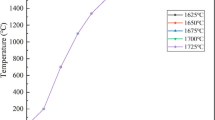The paper examines the effect of additions (TiO2, TiH2, TiN, and TiC up to 4 vol.%) and isothermal holding temperature on the dielectric properties of hot-pressed AlN ceramics in a wide frequency range. It is established that the service characteristics of AlN–TiO2 ceramics show a parabolic dependence on titanium oxide additions: optimal porosity (0.1%), permittivity (9.7), and dielectric loss tangent (1.3 ⋅10−3) are reached with 0.5 to 2 vol.%. TiO2. Additions of TiH2 promote the formation of metallic films, mainly oriented along the pressing direction. The deviation of sintering temperature from the optimal value increases conduction-induced losses since structures with more defects and conducting phases form. It is shown that broadband (103–107 Hz) dielectric spectroscopy can be used to monitor the composite’s microstructure: the frequency of migration polarization dispersion provided information on the effective thickness of the conducting channel and the slope σ(ω) allowed the lattice and jump responses to be differentiated.




Similar content being viewed by others
Notes
Physical meaning of the Debye shielding length corresponds to the average distance the electric field penetrates into semiconductor when the excitation of potential energy is small compared with the heat energy (i.e., the value of the surface potential ys will be less than kT/e).
References
V. I. Kostenko, V. S. Seryogin, L. A. Gorshakova, and A. I. Vassilevich, “Highly thermally conductive aluminum nitride ceramics in space instrumentation: Application prospects,” in: Modern Information and Design Technologies [in Russian], Moscow (2003), pp. 250–256.
L. Islamgazina, Jurgen Shultz-Harder, and S. Valev, “Criteria for the choice of substrates for power modules,” Comp. Techn., No. 38, 60–63 (2004).
Electronic Register. Path to link: http://www.goodfellow.com/pdf/ 442_1111010.pdf.
Y. G. Tkachenko, D. Z. Yurchenko, G. S. Oleynik, et al., “Self-reinforced materials based on aluminum nitride,” Powder Metall. Met. Ceram., No. 9, 69–74 (1992).
S. Kume, M. Yasuoka, N. Omura, and K. Watari, “Effect of additives on dielectric loss of AlN ceramics,” Key Eng. Mater., 317–318, 845–848 (2006).
S.-A. Jang and G. M. Choi, “Effect of dopants on the complex impedance and dielectric properties of aluminum nitride,” J. Am. Ceram. Soc., 75, No. 11, 3145–3148 (1992).
M. R. Freedman, J. D. Kiser, and T. P. Herbell, “Factors influencing the ball milling of Si3N4 in water,” Ceram. Eng. Sci. Proc., 6, No. 7/8, 1124–1134 (1985).
I. V. Brodnikovskaya, Y. V. Vorona, and V. Y. Petrovskii, “Producing high-temperature dielectrics and SiN-based heat-spreading substrates,” Keramika: Nauka i Zhizn, No. 3 (17), 14–29 (2012).
Y. G. Tkachenko, R. A. Morozova, and D. Z. Yurchenko, “Effects of chemicothermal treatment of aluminum nitride powders on the structure and propertiex of the resulting hot-pressed ceramic,” Powder Metall. Met. Ceram., 34, No. 1/2, 69–73 (1995).
D. M. Kazarnovskii and B. M. Tareyev, Test of Insulation Materials [in Russian], Energiya, Leningrad (1969), p. 296.
I. V. Brodnikovska, A. I. Derii, and V. Y. Petrovskii, “Broadband response of AlN ceramic composites,” Proc. Appl. Ceram., 8, No. 1, 47–51 (2014).
K. K. Srivastava, M. Zulfequar, and A. Kumar, “Dielectric behavior of hot-pressed AlN ceramic exposed to inorganic acid vapors,” J. Mater. Sci., 25, No. 6, 2861–2865 (1990).
P. Boch, J. C. Glandus, J. Jarrige, et al., “Sintering, oxidation and mechanical properties of hot-pressed aluminum nitride,” Ceram. Intern., 8, No. 1, 34–40 (1982).
E. M. Trukhan, “Permittivity dispersion of heterogeneous systems,” Fizika Tverd. Tela, 4, No. 12, 3496–3511 (1962).
A. K. Joscher, “The “universal” dielectric response,” Nature, 267, 673–679 (1977).
Author information
Authors and Affiliations
Corresponding author
Additional information
Translated from Poroshkovaya Metallurgiya, Vol. 53, Nos. 5–6 (497), pp. 55–66, 2014.
Rights and permissions
About this article
Cite this article
Brodnikovska, I.V., Derii, A.I. & Petrovskii, V.Y. The Relative Density and Electrical Properties of AlN with Additives Depending on the Composition of the Mixture and the Temperature of hot Pressing. Powder Metall Met Ceram 53, 294–302 (2014). https://doi.org/10.1007/s11106-014-9616-0
Received:
Published:
Issue Date:
DOI: https://doi.org/10.1007/s11106-014-9616-0




